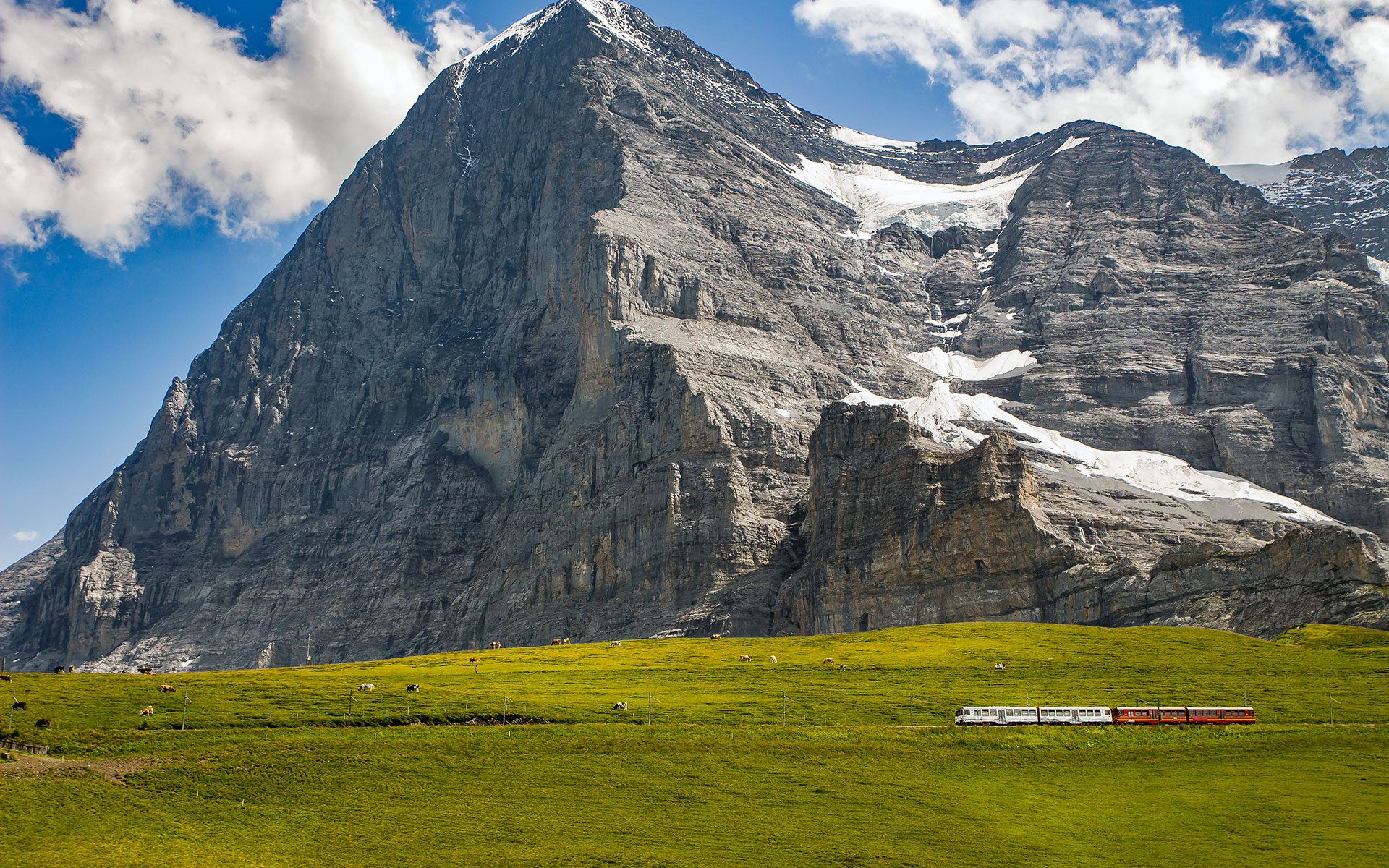A hole in the wall
The North Face of the Eiger in the Swiss Alps (photo © Steven van Aerschot / dreamstime . com).
If you have made it here to the Europe by Rail website you’ve probably already heard of the Jungfraubahn. You’ll know that it runs up to Europe’s highest railway station at the saddle between the Jungfrau and the Mönch, two of the great mountains in the Bernese Alps, and that to get there it tunnels up through the Mönch and a third famous peak – the Eiger. You know how much it costs. And you might even know that until 2016 the Jungfraubahn trains stopped at a station called Eigerwand, behind the North Face of the mountain, with observation windows offering the type of view normally only available to the bravest of climbers. But do you know the story of the Stollenloch, not far from Eigerwand station, where another hole opens out from the railway tunnel onto the rock face via a simple wooden door?
The Stollenloch was created during the construction of the railway, which began in 1896. It was used to remove stone and earth as construction workers tunnelled their way up through the mountain towards the Jungfraujoch. When Eigerwand station and its viewing balconies was opened, the Stollenloch might have been forgotten to all but those with an interest in railway history and railway construction. But it would soon become a place that would go down in the annals of mountaineering history, linking forever the railway on one side of the wall and what was happening out there on the open rock face.
The Eiger was first climbed in 1858 by the Swiss mountain guides Christian Almer and Peter Bohren with their Irish client Charles Barrington. But it was the imposing North Face that would become the iconic mountaineering challenge of the early decades of the 20th century. Known as “the last great problem of the Alps”, it drew climbers from across Europe to camp in the meadows below the face, plotting a route up the 1,800-metre wall of rock. These attempts, and the tragedies that ensued, created the lasting connection between the mountaineering challenges and the railway, as well as turning the Eiger into a place where climbing became a spectacle that drew curious onlookers and the media to this corner of Switzerland.
At the foot of the Jungfrau Railway is the resort of Kleine Scheidegg, located on a mountain pass that not only is the starting point for the railway up through the mountain but also a stop on the Wengernalpbahn with connections to Lauterbrunnen and Grindelwald. The railway brought tourists to stay at hotels in Kleine Scheidegg with spectacular views of the Eiger and the other mountains. This was especially true at the aptly named Hotel Bellevue, where guests would gather around telescopes on the terrace to try and catch a glimpse of climbers high on the North Face, tracking their progress up the wall before stepping back into the warmth for a glass of brandy or wine.
In Kleine Scheidegg and on the Eiger’s North Face, mountaineering became theatre, made all the more dramatic for the deadly outcome of many of the early attempts. In 1935, a break in the clouds allowed those in Kleine Scheidegg a glimpse of German climbers Karl Mehringer and Max Sedlmeyer making steady progress towards the summit – but as the clouds closed in, it would be the last time anyone saw them alive. A year later and another attempt at the North Face by a team made up of Andreas Hinterstoisser and Toni Kurz from Germany and Willy Angerer and Edi Rainer from Austria. Once again it ended in disaster, with all four climbers losing their lives, despite a brave rescue attempt that was launched from the Stollenloch after a railway guard heard the desperate cries of Toni Kurz, dangling from a rope just a short distance from the tunnel opening. Unfortunately the rescuers could not get close enough to save him, while down in Kleine Scheidegg the press and public gathered on the hotel terraces, “in thrall to the exquisite horror,” of what was taking place above, in the words of a BBC reporter.
A year later the North Face of the Eiger would be successfully climbed by a German team, but over the years that followed the Stollenloch and the railway line behind the face would continue to play a crucial role in rescue attempts, with special trains delivering rescue teams to the little hole in the wall or climbers themselves collapsing in off the icy rock face in relief that, unlike any mountain anywhere else, there was this little wooden door in the wall that could lead them out of danger. The names of the climbers who used the railway and the Stollenloch to save themselves or their friends is a who's who of mountaineering greats, including Chris Bonington, Don Whillans, Toni Hiebeler and John Harlin, although whether Clint Eastwood made use of the Stollenloch while filming The Eiger Sanction is unrecorded.
Today the trains no longer stop at Eigerwand station, and the views from the North Face have become once more the privilege of those who brave the rocky wall. Climbers still know that through the wooden door of the Stollenloch is a way out of trouble if they get into difficulty or the weather turns bad, and climbing companies still get permission to take tours up on the train to give mountaineers the chance to experience what it’s like on the North Face without committing to attempting the entire route. Which side of the Stollenloch door you prefer to be on remains the dividing line between the mountaineers, drawn to the high places, and those for whom the mere thought makes them shiver. Thankfully those in the latter category can simply enjoy the views from the comfort of a Kleine Scheidegg hotel room or take a seat on the train as it travels up through the mountain, on the way passing that little hole in the wall.







About The Author
Paul Scraton
Paul Scraton was born in Lancashire and has lived in Berlin since 2001. A writer with a particular interest in landscape, memory and place, he is the editor-in-chief of Elsewhere: A Journal of Place. He is the author of a number of books including The Idea of a River: Walking out of Berlin (Readux, 2015) and Ghosts on the Shore: Travels along Germany's Baltic coast (Influx, 2017). His debut novel Built on Sand was published by Influx in 2019. Find out more about Paul on his website.